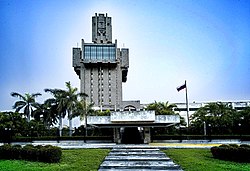| Embassy of Russia, Havana | |
|---|---|
 | |
 Interactive map of Embassy of Russia, Havana | |
| General information | |
| Architectural style | Constructivism, Brutalism |
| Coordinates | 23°06′45″N82°26′09″W / 23.11250°N 82.43583°W |
| Construction started | 1978 |
| Completed | 1987 |
| Design and construction | |
| Architect | Aleksandr Rochegov |


The Embassy of Russia in Havana is the headquarters of the diplomatic mission of the Russian Federation in the Republic of Cuba. It is well known for its striking constructivist building in the Miramar district of the city, built by architect Aleksandr Rochegov. Some liken it to a sword, others to a syringe. [1] [2]